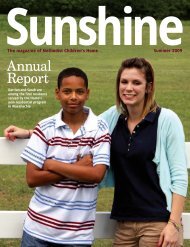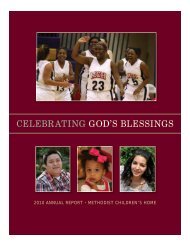Sunshine
Land of opportunity - Methodist Children's Home
Land of opportunity - Methodist Children's Home
You also want an ePaper? Increase the reach of your titles
YUMPU automatically turns print PDFs into web optimized ePapers that Google loves.
Dottie Briggs, administrator at the Boys Ranch, understands<br />
the importance of providing a variety of activities for youth. She<br />
knows that when youth become connected to the Ranch through<br />
activities and relationships, they are more likely to invest in the<br />
program of care and experience positive change in their lives.<br />
“Youth have different personalities and needs, and it is our<br />
responsibility to offer opportunities that will enable them to<br />
develop their interests and become connected to our staff and<br />
program,” she said. “It doesn’t take long to figure out that what<br />
works for one young person doesn’t work for another. We have to<br />
individualize our approach to working with youth.”<br />
Beginning with their initial tour of the campus, youth learn<br />
that the Boys Ranch is a place where they can discover their niche,<br />
whether it is through FFA, basketball, work crew, outdoor activities<br />
or community service, and develop positive relationships with<br />
staff and peers. Caring adults who help youth develop a sense of<br />
belonging, learn new skills and gain self-confidence lead all programs<br />
at Methodist Children’s Home. Staff members realize that<br />
their ultimate goal is to help youth discover hope for their future.<br />
“Building relationships is our first priority,” Briggs said. “If<br />
youth don’t trust us, they’re not going to listen to us.”<br />
Significant relationships are established in many ways at<br />
the Boys Ranch. Examples include: homeparents who create a<br />
warm and inviting home for their boys to enjoy; staff members<br />
who work alongside youth to help maintain the physical grounds<br />
and Ranch vehicles; adults who teach boys how to fish or develop<br />
their basketball skills; homeparents who make an extra effort to<br />
prepare a special snack for their boys or celebrate their birthdays;<br />
cooks who visit with boys as they go through the serving line in<br />
the dining hall; and youth care counselors who provide a listening<br />
ear to residents who need to talk before they end their day.<br />
Through these shared experiences, youth develop trust in<br />
their relationships with adults and become more comfortable<br />
communicating with staff as they share their frustrations and seek<br />
advice from the men and women who care for them.<br />
“Our young people deal with so many challenges and come<br />
from so many different backgrounds and experiences, they just<br />
don’t know who they can trust,” said Karen Melton, director of<br />
program services. “It takes them awhile to realize that what we’re<br />
offering them is positive and in their best interest.”<br />
As part of her job, Melton works with recreation coordinator<br />
Pablo Villanueva to ensure youth receive plenty of opportunities<br />
to have fun and build positive relationships.<br />
“Recreation is one of the most effective ways to break through<br />
barriers in relationships,” Melton said. “Youth can learn to have<br />
fun and to laugh again. Through that process, they build and<br />
strengthen relationships with their peers and staff.”<br />
Continued, pg. 6<br />
Campus tours provide inside<br />
look at life at the Boys Ranch<br />
by RICHARD MCMULLEN, Unit Manager<br />
Imagine you are a teenager who is considering living at the Methodist<br />
Children’s Home Boys Ranch. Perhaps you are 16 years old and grew<br />
up in Dallas, and the closest you ever came to a farm animal is the<br />
bacon and eggs you ate for breakfast.<br />
It’s a sunny afternoon and you’re walking with your family on a<br />
tour of the 500-acre Boys Ranch. You want to see the place before<br />
you agree to be part of the<br />
program. The man giving<br />
the tour, Mr. James, says the<br />
Ranch program is based on<br />
“positive relationships.” You<br />
see the homes where the<br />
boys live and the dining hall.<br />
You see cattle and horses<br />
grazing, but you only get an<br />
impression, you do not really<br />
feel “connected.”<br />
The walking tour continues.<br />
You see men and boys<br />
working with cows, hogs,<br />
goats, sheep and even quail.<br />
POOL TOURNAMENT CHAMP<br />
Jeremy earned first place in the Boys Ranch pool<br />
tournament in January. His name was engraved on a<br />
plaque that is displayed at the Ranch. The tournament,<br />
hosted by the recreation department, is one of<br />
many activities that enable residents to connect to<br />
campus life and strengthen relationships.<br />
Wrangler and his steer relax at the<br />
Heart of Texas Livestock Show. Boys<br />
Ranch youth build strong bonds<br />
with their animals, which help them<br />
develop positive relationships with<br />
peers and adults.<br />
The quail make funny noises and move around quickly. You see boys<br />
cutting weeds around a pond. Mr. James stops and introduces you<br />
to Mr. Jim. You ask about their work. Mr. Jim explains how the boys<br />
are taking care of the pond to ensure it remains a good fishing hole.<br />
Mr. James brags on Mr. Jim, noting how he has caught and released<br />
a 5-pound bass from that pond four times. It’s obvious that Mr. Jim<br />
knows a lot about fishing.<br />
Mr. James leads you to the steer barn and you meet Mr. Garza,<br />
who supervises boys as they work with a calf. He explains that last<br />
fall the calf was orphaned after its mother fell ill, and boys took turns<br />
hand-feeding the calf from a gallon-sized milk bottle. Now the calf<br />
eats whole food. One boy who looks about your age says he plans to<br />
raise the calf and show it in the fall for FFA. Mr. Garza says he likes<br />
working with the steers because they follow you around if you treat<br />
them right.<br />
Next you walk to the hog barn and meet Mr. Stone and Mr. Pat.<br />
Several days earlier they helped the sows give birth. You start to<br />
feel connected as you hear baby pigs squealing, nestled around their<br />
mommas, and you get to hold a piglet. Mr. Stone says he likes the<br />
hogs best because they are intelligent, as smart as dogs.<br />
Mr. Pat tells you that the baby you are holding can grow to 250<br />
pounds in six months and some of the hogs weigh over 400 pounds. Mr.<br />
James comments that someone once asked Mr. Stone if the Ranch had<br />
anger management classes, and Mr. Stone replied, “If a hog steps on<br />
your foot, we may talk about anger management.”<br />
You tell Mr. Stone and Mr. Pat it was nice to meet them and they<br />
say the same to you. As you walk away with your family, you say to<br />
them, “I think I might like it here.”<br />
<strong>Sunshine</strong> I Spring 2009 5
















